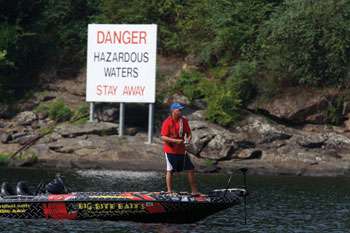
Watching the river flow is all Russ Lane needs to do to determine if a tailrace will produce for him during a tournament.
"You don't have to count on the sun shining for you or the clouds coming in or (any) of that stuff," Lane says. "Current forces bass to do what they are going to do, and for the most part they are going to hide behind current breaks. If there is a situation at any event we go to where there is current, I try to explore a tailrace a little bit because it can be more reliable than anything else."
The Bassmaster Elite Series competitor from Prattville, Ala., discovered the reliability of tailraces while honing his skills on the Alabama and Coosa river systems. "That was probably one of the first things I figured out when I first started fishing tournaments," Lane reveals. "That was a good way to win because it was a big-fish deal." His tailrace tactics usually produce hefty spotted bass throughout the year, but he does catch some largemouth in the current during the summertime.
The velocity of the current determines whether Lane fishes close to the dam or farther downstream. "You just want to get in a situation where the current is fast enough that it can place the fish behind different objects without pushing them completely into a backwater area," Lane says.
The Alabama pro watches how his lures react to the water flow to tell if the current is suitable for his presentation. "I try to keep my bait in contact with the bottom, and if I am not able to keep it there through experimenting with weight and line size then I probably need to go back downriver a little bit to find a softer current," he says.
Once he finds the right current speed, Lane surveys the area for any obstructions that change the current's course. A visible current break Lane keys on sometimes is a big, slick laydown log that has lost all of its branches. "For some reason, the fish sit behind those better than other wood," discloses Lane.
Concrete slabs for power lines that run across the river also attract bass seeking shelter from the current. "The only problem with the obvious man-made structure is that everybody fishes it," says Lane, who recommends trying these current breaks during the week when fishing pressure is light.
Any rocks jutting out from the bank also break the current, but Lane's favorite current breaks in tailraces are underwater rocks that he finds with his electronics. When presenting lures to this type of current break, Lane envisions these rocks creating a vertical eddy instead of the horizontal eddy he sees behind current breaks on the surface.
"You want to imagine how the water is flowing underneath," he describes. "If you look at the surface when the water comes around a point, it makes an eddy, and that eddy will be turning sideways. Under the surface, the water rolls over a rock, then rolls back in a circle under the rock and comes back up. That is still an eddy which is turning up and down in the water column (rather than across the water)." Bass usually position in the slack water behind the submerged rocks waiting for prey to wash into the eddy.
Lane relies mainly on two heavyweight lures for tricking bass lurking around the current breaks. The four-time Bassmaster Classic qualifier usually positions his boat downstream from the underwater break and slow rolls with the current a white or chartreuse 3/4-ounce Buckeye spinnerbait with a single-tail Big Bite Baits grub. "You want to feel the blade turning but you still want to keep contact with the bottom," he advises.
If the spinnerbait doesn't produce, which isn't often, a 1-ounce Buckeye football jig with a YoMama crawfish trailer also triggers strikes from bass hiding behind the submerged rocks. He bumps this jig along the bottom with the current, pausing it when it hits an eddy.
Heavy Tackle For Heavy Current
Tailrace current tends to push around Russ Lane's lures, so he depends on heavy tackle to control his presentation. The tailrace expert relies on 15- to 20-pound Sunline Sniper fluorocarbon for bumping his jigs along the rocky bottom and 20-pound Sunline Sniper for slow rolling his 1-ounce spinnerbait. The heavy line reduces abrasion when it scrapes the rocky bottom, but the stiffer line also tends to bow as the lure drifts with the current. Using a stout rod such as a 7-foot extra-heavy action e21 Carrot Stix rod allows Lane to detect strikes better and generate more solid hook sets despite the bowing line.
A high-speed Abu Garcia Revo Premier baitcast reel with a 7.1:1 gear ratio is Lane's choice for keeping up with his lure in the current and preventing it from snagging as it bumps the bottom





